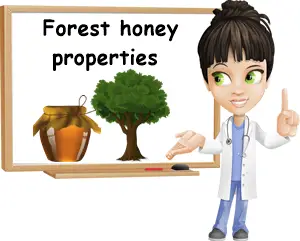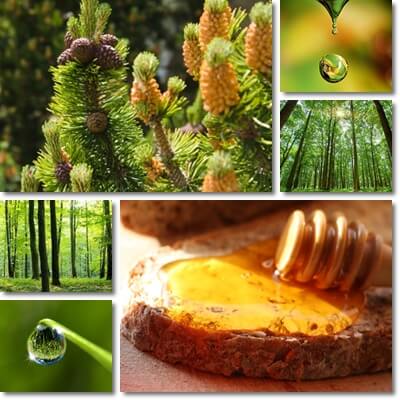Forest honey is a general name given to varieties of honey made not from flower nectar, but from a sugary secretion of certain insect species that eat plant sap. It is also commonly called honeydew honey or tree honey. As its name suggests, the plant sap that the insects feed on, then excrete for honey bees to use comes primarily from trees rather than smaller plants because trees are a more abundant source of sap. However, forest honey can also be made from various grasses or other smaller plants that produce sap, but in smaller amounts.
How is forest honey (honeydew honey) made?
Certain species of small insects such as aphids feed on tree sap, a watery substance that contains sugars and trace amounts of various nutrients. The insects digest the tree sap in order to gain access to its nutrients. They then excrete a sticky, sugary liquid called honeydew which sticks to various parts of the tree such as the leaves, branches or trunk.
This is why honeydew appears to be secreted directly by the tree and leads many people to believe that forest honeys are made from tree sap, when instead they are made from the honeydew excreted by the insects that feed on the tree sap.

What is the difference between forest honeys and flower honeys?
Forest honeys are made from honeydew, a sticky, sugar-based waste product excreted by insects that feed on tree sap. Flower honeys are made from the nectar of blossoming flowers. In the first case, bees feed on the honeydew secreted by certain insect species, while in the second case they feed directly of the flower nectar. Some species of plants can be the source for both forest and flower honey. For example, citrus honeydew honey and citrus blossom honeys are made from different substances from the same tree species.
What is the difference between honeydew and flower nectar?
While they are not the same, both honeydew and flower nectar have a rather similar composition, with a generous content of natural sugars and trace amounts of nutrients, notably vitamins, minerals and amino acids (protein). Examples of forest honeys: forest honey comprises varieties such as pine honey, silver fir honey, oak honey, spruce honey, beechwood honey etc.
What does forest honey look like?
Generally, forest honeys have a darker color, medium to dark amber, some with reddish, greenish or brown highlights. Some varieties have such a dark color that they appear almost black. Most varieties have a thick consistency and a smooth texture which make them all the more appealing. Some take very long to crystallize, while others have a medium crystallization time.
What does forest honey taste and smell like?
Generally, the darker the pigment, the more aromatic the honey. Forest honeys tend to have a medium taste intensity and are moderately sweet. Most varieties have a mild warm, woody, resinous aroma, with various notes, depending on the species of insect and species of tree the honey was made from. For example, forest honeys may have warm-spicy, caramel, malty, smoky, resin, cooked fruit flavor notes and sometimes a slight astringency to them or a barely perceptible bitter aftertaste.
You might be interested: Does Honey Expire?

What is it good for?
What are the health benefits of forest honey? Given its unique flavor profile and other particular characteristics, forest honey has some very special properties and benefits such as:
1) Rich antibacterial properties. Forest honeys owe their impressive antibacterial properties to their acidic pH and low moisture content which reduce bacteria numbers. But more important, to their content of hydrogen peroxide, a powerful disinfectant that occurs naturally in most honeys as a result of the reaction between glucose, a sugar from honey, and glucose oxidase, an enzyme secreted by honey bees when they make the honey. Forest honeys are thus good for a sore throat, soothe cough and may promote a faster recovery after respiratory infections, provided we are not allergic to them.
2) Lower glycemic index. On average, forest honeys have a lower glycemic index than flower honeys. If you are looking for ways to enjoy something sweet and healthy and manage your weight, forest honeys might be a better choice. However, if you are suffering from diabetes or other medical conditions that may be influenced by sugar consumption, first ask your doctor if eating forest honey or other honey varieties is good for you or not.
3) Strong soothing properties. The thick consistency, low moisture content and antibacterial action of forest honeys recommend them for soothing throat soreness caused by respiratory tract infections. You can add them to tea after it’s cooled down (heat destroys its beneficial properties) or just have one tablespoon of honey several times a day and avoid eating or drinking anything for at least an hour afterwards. Some people take a tablespoon of honey on an empty stomach in the morning to help soothe stomach lining inflammation in gastritis. Eating and drinking is postponed for about an hour.
4) Rich nutritional profile. Forest honey contains small amounts of a variety of vitamins, notably vitamin C, folic acid, vitamin B6 (pyridoxine), vitamin B5 (pantothenic acid) and trace amounts of niacin, riboflavin and thiamine. It also contains varying amounts of dietary minerals such as potassium, magnesium, phosphorus, calcium, sodium, selenium and copper. Some varieties can be extremely rich in potassium (up to 3,500 mg/100 g of honey), but amounts vary immensely depending on the source of the honey, variety, season, weather conditions, bee hive health and from batch to batch (Nutraceutical values of natural honey and its contribution to human health and wealth).
5) Contains valuable antioxidants. Forest honeys, which are darker in color, have been found to have a superior antioxidant value than often light-colored floral honeys. Antioxidants fight against oxidative stress caused by harmful free radicals and prevent cell damage from accumulating and producing disease. Antioxidants from forest honey are believed to offer antioxidant protection against disease and premature aging.
6) Tonic effects. Forest honey is energizing not only because of its generous content of natural sugars that give us instant energy and help prevent hypoglycemic states, but also because of its nutritional value, providing important vitamins and minerals that further contribute to raising energy levels.
7) Good for the skin. Honey makes a great natural face mask and helps unclog pores and get rid of blackheads. This combined with its antibacterial effects makes it great for preventing acne breakouts when used consistently. In my experience, it also tightens skin and makes it softer. I apply a layer of raw honey on a make-up free face by gently rubbing it in the skin, let it sit for 20 minutes, after which I wash my face with lukewarm water.
Forest honey and pollen content
Forest honeys shouldn’t normally contain pollen because they are made from honeydew. However, because honey bees don’t discriminate between food sources, it is possible they collect nectar from flowers that may happen to be in blossom in the area along with honeydew. So forest honeys may still contain pollen, which is added accidentally, meaning they do have allergenic potential. The risk for an allergic reaction is greater for anyone allergic to honey bee secretions which are present in all honey varieties or to pollen in general.
To consider
There is always the possibility of contamination and pollution with heavy metals or various chemicals and a resulting honey that doesn’t deliver the promised benefits. This is why it is important to know the origin of our honey and choose certified organic honey from controlled, closely monitored supply chains or small businesses that cater to clean honey production.
